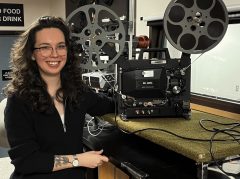 During the final year of my MA in Film Studies, I had the incredible opportunity to work in the Audio-Visual Resource Center (AVRC) as the Collections Assistant through the Young Canada Works Program. The AVRC holds extensive collections related to Film Studies, Music, and Art History and, while I was aware of such collections through my undergraduate degree completed at Carleton in Film Studies and History, the ability to work closely with such collections was extremely valuable to me as it granted me the opportunity to combine both my interest in Film Studies and History.
During the final year of my MA in Film Studies, I had the incredible opportunity to work in the Audio-Visual Resource Center (AVRC) as the Collections Assistant through the Young Canada Works Program. The AVRC holds extensive collections related to Film Studies, Music, and Art History and, while I was aware of such collections through my undergraduate degree completed at Carleton in Film Studies and History, the ability to work closely with such collections was extremely valuable to me as it granted me the opportunity to combine both my interest in Film Studies and History.
My long-term project throughout the 2022/2023 school year involved working with the AVRC’s collection of 20th/21st century 35mm slides, deaccessioning slides that were either of poor quality, including discoloured images or duplicates of the same image, or readily available online in good quality, either through public domain sites, such as WikiMedia Commons, or through online museum collections, such as, but not limited to, MoMA, Tate, Philadelphia, or Carleton’s own MDID collection. By doing this, I provided more space in the AVRC’s collection room for new acquisitions, while also ensuring that future students will have access to better quality images for their studies.
When not working through the collection of 20th/21st century 35mm slides, I had the opportunity to digitize and catalog Brian Foss’ collection of 35mm slides of Mary Hiester Reid’s artwork, a celebrated Canadian artist whose work is not readily available online. Removing any dust or debris from the slide, I scanned each individual slide and processed the images using Photoshop. There, I slightly adjusted the image, finding the correct balance between editing out any significant scratches or remaining dust particles while still maintaining the integrity of the original image. After completing this, I cataloged the images in the AVRC’s database, a searchable tool that students and professors can use for their own research or classes. Such a process allowed me to expand my cataloging experience, building on the tools I learned in my undergraduate degree, while also giving me the new experience of digitizing slides.
Overall, though, the most meaningful experience I had during my time with the AVRC was the 16mm film evaluations, which included projecting Carleton’s vast collection of 16mm films, documenting any visual or audio issues, as well as if the films are available online in better condition. After viewing each film, I then checked, by hand, for any issues with the emulsion, base, cleanliness, warping, perforations, edges, splices, and whether or not the films were suffering from vinegar syndrome. In addition to this, I learned how to splice any breakages that might have occurred during the projection process. Being given the ability to learn how to use Eiki and Kodak projectors, and to spend hours with analog film and equipment, was a pleasure, and a blessing, that I will carry with me for the rest of my life!
The whole AVRC team — Nancy, Jenna, Adam, and Paul — are an absolute delight to work with and have taught me skills that I will value in all my future endeavours. The ability to work in a place surrounded by music, art, and film was an absolute delight and I am truly grateful for this experience! I urge all students to participate in the Young Canada Works program here at the AVRC!